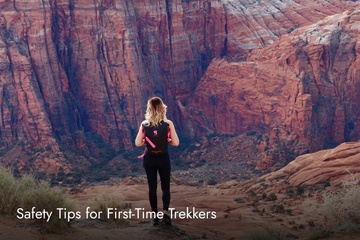Trekking Safety Tips: A Simple Guide for New Hikers

Trekking is a wonderful way to explore nature, exercise, and enjoy the outdoors. But if you're new to it, being well-prepared is crucial. Safety should always come first. Here are some easy-to-follow tips and must-have supplies to ensure your first trek is safe and enjoyable.
Plan Your Trek Carefully
Before you hit the trail:
- Take some time to plan your trek.
- Start by researching about the trail you'll be hiking—find out its length, how tough it is, and if there are any specific challenges.
- Check the weather forecast for the day of your hike and plan your gear accordingly.
- Tell someone about your plans, including where and when you expect to return.
This way, they can alert authorities if you return differently than expected.
Dress the Part
What you wear on your trek can greatly affect your comfort and safety. Dress in layers to easily adjust to changing temperatures. Choose clothes made from moisture-wicking materials to keep sweat away from your skin. And, of course, wear a sturdy pair of hiking boots to protect your feet and provide a good grip on different terrains.
Stay Hydrated and Energized
Water is your best friend on a trek. Whether you choose a hydration pack or a reusable water bottle, bring enough to stay hydrated. High-energy snacks like nuts, dried fruits, and energy bars are also essential to keep your energy levels up throughout your hike.
Essential Safety Gear
-
Backpacks: A reliable backpack is key to carrying all your essentials. Look for one that's lightweight but roomy, with padded straps and multiple compartments to keep your gear organized.
-
Waist Packs and Totes: For shorter treks, a waist pack or tote can be handy for carrying smaller items like your phone, snacks, and a small first aid kit.
-
Coolers: A portable cooler can be a great option if you plan a longer hike and need to keep food fresh. Go for a compact one that's easy to carry.
-
Phone Dry Bags: Keep your phone safe from water and dirt with a dry bag, especially if you expect rain or need to cross water.
-
Waterproof Belt Bag: A waterproof belt bag is perfect for keeping essentials like your map, compass, or snacks safe and within easy reach.
-
Mobile Phone Pouch: Use a mobile phone pouch to attach to your bag or belt for extra protection.
-
Backpack Duffel: Consider a backpack duffel for longer treks, which gives you extra space and versatility. It can be worn as a backpack or carried like a duffel bag.
-
Hybrid Lightweight Backpack: If you want something that combines the features of a traditional backpack with a lightweight design, this is your best bet. It allows you to carry all your essentials without feeling weighed down.
-
Coozies: If you're hiking in hot weather, coozies are great for keeping your drinks cool.
-
Dry Boxes: Use dry boxes to keep your gear safe from water damage. They're ideal for storing your phone, camera, and important documents you may need on your hike!
First Aid Kit
Every hiker should have a first aid kit. It should include basics like bandages, antiseptic wipes, pain relievers, blister treatment, and any personal medications you might need. Knowing some basic first aid procedures in case of minor injuries is also helpful.
Navigation Tools
Even if you have a GPS device or a smartphone with maps, always bring a map and compass as a backup. Electronic devices can fail, so knowing how to navigate the old-fashioned way is important. Make sure you understand how to use these tools before setting off.
Weather Protection
Weather can change quickly outdoors, so be prepared. Pack a lightweight, waterproof jacket to stay dry during sudden rain showers. A wide-brimmed hat and sunscreen will help protect you from the sun.
Communication
Make sure you have a way to communicate in case of an emergency. Cell phone coverage can be spotty in remote areas, but a phone with a fully charged battery is still useful. A whistle is also a good idea for signalling for help if you need it.
Be Aware of Wildlife
Before you go, learn about the wildlife in the area you'll be trekking. Knowing what animals you might encounter and how to deal with them is crucial. Store your food properly to avoid attracting animals, and make sure you know what to do if you run into wildlife.
Respect Nature
Always follow the Leave No Trace principles. This means packing out your trash, sticking to marked trails, and not disturbing wildlife. By doing this, you'll help preserve the beauty of nature for others to enjoy.
The Buddy System
Trekking with a buddy is safer and can make the experience more fun. If you can't bring someone along, ensure someone knows your plans and when you expect to return.
Be Prepared for Emergencies
Know the nearest place to get help in case of an emergency. Carrying an emergency blanket, a multi-tool, and a fire starter can be lifesavers in unexpected situations.
Hiking and trekking can be a rewarding experience, offering stunning views, fresh air, and a chance to reconnect with nature. By planning carefully, dressing appropriately, and carrying the right safety gear, you can ensure your first trek is safe and enjoyable. Preparation is key, and safety should always be your top priority. Now, go out and enjoy your adventure in the great outdoors!

